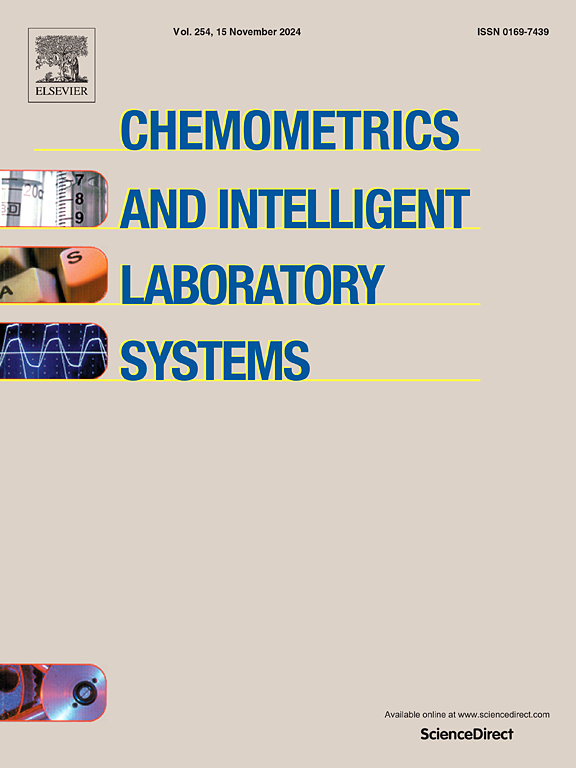基于开发一种新型智能化学计量学辅助电化学生物传感器的生物电化学计量学,用于肌酸酐的多酶生物传感
IF 3.8
2区 化学
Q2 AUTOMATION & CONTROL SYSTEMS
Chemometrics and Intelligent Laboratory Systems
Pub Date : 2025-07-18
DOI:10.1016/j.chemolab.2025.105490
引用次数: 0
摘要
肌酸酐(CT)是肌肉和蛋白质代谢中磷酸肌酸的分解产物。健康的肾脏会过滤掉血液中的CT。CT作为尿液中的废物排出体外。高水平是肾脏问题的信号。CT血液检查测量血液中的CT水平。这项检查是为了了解肾脏的工作情况。因此,测定血液等生物液体中的CT是很重要的。在这项工作中,基于多壁碳纳米管离子液体(MWCNTs-IL)修饰玻璃碳电极(GCE),并在其表面固定三种特定酶,包括肌酸酐氨基水解酶(CNN),肌酸氨基水解酶(CRN)和肌氨酸氧化酶(SOX),制备了一种新型生物传感器,用于检测CT。以中心复合设计(CCD)为实验设计方法,通过偏最小二乘-1 (PLS-1)、递推加权偏最小二乘(rPLS)、最小二乘支持向量机(LS-SVM)、主成分回归(PCR)、连续功率回归(CPR)、稳健连续回归(RCR)、反向传播-人工神经网络(BP-ANN)等方法对生物传感器在最佳条件下的安培响应进行建模,以利用一阶优势。小波变换-人工神经网络(WT-ANN)、偏鲁棒m回归(PRM)、离散小波变换-人工神经网络(DWT-ANN)、径向基函数-人工神经网络(RBF-ANN)和径向基函数-偏最小二乘(RBF-PLS),选择最佳算法辅助生物传感器测定血液样本CT。RBF-ANN辅助CNN-CRN-SOX-MWCNTs-IL/GCE测定血液样品中0.1 ~ 18 pg mL−1的CT,检出限为0.015 pg mL−1,定量限为0.049 pg mL−1,灵敏度为3.81 μA pg−1 mL,结果与高效液相色谱(HPLC)作为参考方法一致。本文章由计算机程序翻译,如有差异,请以英文原文为准。
Bioelectrochemical metric based on developing a novel and intelligent chemometrics-assisted electrochemical biosensor for multi-enzymatic biosensing of creatinine
Creatinine (CT) is a breakdown product of creatine phosphate from muscle and protein metabolism. Healthy kidneys filter CT out of the blood. The CT exits body as a waste product in urine. High levels can signal kidney issues. The CT blood test measures the level of CT in the blood. This test is done to see how well the kidneys are working. Therefore, determination of CT in biological fluids such as blood is important. In this work, a novel biosensor was fabricated based on modification of a glassy carbon electrode (GCE) with multiwalled carbon nanotubes-ionic liquid (MWCNTs-IL) and immobilization of three specific enzymes including creatinine amidohydrolase (CNN), creatine amidinohydrolase (CRN), and sarcosine oxidase (SOX) onto its surface for determination of CT. Amperometric responses of the biosensor recorded at optimal conditions found by a central composite design (CCD) as an experimental design approach were modeled for exploiting first-order advantage by partial least squeares-1 (PLS-1), recursive weighted partial least squares (rPLS), least square-support vector machine (LS-SVM), principal component regression (PCR), continuum power regression (CPR), robust continuum regression (RCR), back propagation-artificial neural networks (BP-ANN), wavelet transform-artificial neural networks (WT-ANN), partial robust M-regression (PRM), discrete wavelet transform-artificial neural networks (DWT-ANN), radial basis function-artificial neural networks (RBF-ANN), and radial basis function-partial least squares (RBF-PLS), to select the best algorithm to assist the biosensor for determination of CT in blood samples. The RBF-ANN showed the best performance to assist the CNN-CRN-SOX-MWCNTs-IL/GCE for determination of CT ranging from 0.1 to 18 pg mL−1 with a limit of detection of 0.015 pg mL−1, a limit of quantification of 0.049 pg mL−1 and a sensitivity of 3.81 μA pg−1 mL in blood samples, and its results were in a good accordance with high-performance liquid chromatography (HPLC) as the reference method.
求助全文
通过发布文献求助,成功后即可免费获取论文全文。
去求助
来源期刊
CiteScore
7.50
自引率
7.70%
发文量
169
审稿时长
3.4 months
期刊介绍:
Chemometrics and Intelligent Laboratory Systems publishes original research papers, short communications, reviews, tutorials and Original Software Publications reporting on development of novel statistical, mathematical, or computer techniques in Chemistry and related disciplines.
Chemometrics is the chemical discipline that uses mathematical and statistical methods to design or select optimal procedures and experiments, and to provide maximum chemical information by analysing chemical data.
The journal deals with the following topics:
1) Development of new statistical, mathematical and chemometrical methods for Chemistry and related fields (Environmental Chemistry, Biochemistry, Toxicology, System Biology, -Omics, etc.)
2) Novel applications of chemometrics to all branches of Chemistry and related fields (typical domains of interest are: process data analysis, experimental design, data mining, signal processing, supervised modelling, decision making, robust statistics, mixture analysis, multivariate calibration etc.) Routine applications of established chemometrical techniques will not be considered.
3) Development of new software that provides novel tools or truly advances the use of chemometrical methods.
4) Well characterized data sets to test performance for the new methods and software.
The journal complies with International Committee of Medical Journal Editors'' Uniform requirements for manuscripts.

 求助内容:
求助内容: 应助结果提醒方式:
应助结果提醒方式:


